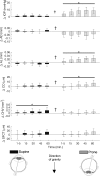Ocular changes over 60 min in supine and prone postures
- PMID: 28546470
- PMCID: PMC6157476
- DOI: 10.1152/japplphysiol.00687.2016
Ocular changes over 60 min in supine and prone postures
Abstract
Some astronauts are returning from long-duration spaceflight with structural ocular and visual changes. We investigated both the transient and sustained effects of changes in the direction of the gravity vector acting on the eye using changes in body posture. Intraocular pressure (IOP; measured by Perkins tonometer), ocular geometry (axial length, corneal thickness, and aqueous depth-noncontact biometer), and the choroid (volume and subfoveal thickness optical coherence tomography) were measured in 10 subjects (5 males and 5 females). Measures were taken over the course of 60 min and analyzed with repeated-measures analysis of covariance to assess the effects of posture and time. In the supine position, choroidal volume increased significantly with time (average value at <5 min = 8.8 ± 2.3 mm3, 60 min = 9.0 ± 2.4 mm3, P = 0.03). In the prone position, IOP and axial length increased with time (IOP at <5 min 15 ± 2.7 mmHg, 60 min = 19.8 ± 4.1 mmHg, P < 0.0001; axial length at <5 min = 24.29 ± 0.77 mm, 60 min = 24.31 ± 0.76 mm, P = 0.002). Each increased exponentially, with time constants of 5.3 and 14 min, respectively. Prone corneal thickness also increased with time (<5 min = 528 ± 35 μm, 60 min = 537 ± 35 μm3, P < 0.001). Aqueous depth was shortened in the prone position (baseline = 3.22 ± 0.31 mm, 60 min = 3.18 ± 0.32 mm, P < 0.0001) but did not change with time. The data show that changes in the gravity vector have pronounced transient and sustained effects on the geometry and physiology of the eye.NEW & NOTEWORTHY We show that gravity has pronounced transient and sustained effects on the eye by making detailed ocular measurements over 60 min in the supine and prone postures. These data inform our understanding of how gravitational forces can affect ocular structures, which is essential for hypothesizing how ocular changes could occur with microgravity exposure.
Keywords: choroidal volume; intraocular pressure; ocular geometry; visual impairment and intracranial pressure.
Copyright © 2017 the American Physiological Society.
Figures



Similar articles
-
Acute effects of postural changes and lower body positive and negative pressure on the eye.Front Physiol. 2022 Aug 31;13:933450. doi: 10.3389/fphys.2022.933450. eCollection 2022. Front Physiol. 2022. PMID: 36117718 Free PMC article.
-
Acute effects of changes to the gravitational vector on the eye.J Appl Physiol (1985). 2016 Apr 15;120(8):939-46. doi: 10.1152/japplphysiol.00730.2015. Epub 2015 Dec 10. J Appl Physiol (1985). 2016. PMID: 26662052
-
Intraocular pressure and choroidal thickness respond differently to lower body negative pressure during spaceflight.J Appl Physiol (1985). 2021 Aug 1;131(2):613-620. doi: 10.1152/japplphysiol.01040.2020. Epub 2021 Jun 24. J Appl Physiol (1985). 2021. PMID: 34166098 Free PMC article.
-
The effect of microgravity on ocular structures and visual function: a review.Surv Ophthalmol. 2013 Mar-Apr;58(2):155-63. doi: 10.1016/j.survophthal.2012.04.002. Epub 2013 Jan 29. Surv Ophthalmol. 2013. PMID: 23369516 Review.
-
Intraocular pressure in microgravity.J Clin Pharmacol. 1991 Oct;31(10):947-50. doi: 10.1002/j.1552-4604.1991.tb03654.x. J Clin Pharmacol. 1991. PMID: 1761725 Review. No abstract available.
Cited by
-
Microgravity-induced ocular changes are related to body weight.Am J Physiol Regul Integr Comp Physiol. 2018 Sep 1;315(3):R496-R499. doi: 10.1152/ajpregu.00086.2018. Epub 2018 May 16. Am J Physiol Regul Integr Comp Physiol. 2018. PMID: 29768035 Free PMC article.
-
Long-duration spaceflight alters estimated intracranial pressure and cerebral blood velocity.J Physiol. 2021 Feb;599(4):1067-1081. doi: 10.1113/JP280318. Epub 2020 Nov 11. J Physiol. 2021. PMID: 33103234 Free PMC article.
-
Twenty-four hour diurnal variation in retinal oxygen saturation.Vision Res. 2023 Dec;213:108314. doi: 10.1016/j.visres.2023.108314. Epub 2023 Aug 30. Vision Res. 2023. PMID: 37657366 Free PMC article.
-
Differences Between Angle Configurations in Different Body Positions by Ultrasound Biomicroscopy in Patients with Cortical Age-Related Cataract.Clin Interv Aging. 2023 May 15;18:799-808. doi: 10.2147/CIA.S408798. eCollection 2023. Clin Interv Aging. 2023. PMID: 37215396 Free PMC article.
-
Acute effects of postural changes and lower body positive and negative pressure on the eye.Front Physiol. 2022 Aug 31;13:933450. doi: 10.3389/fphys.2022.933450. eCollection 2022. Front Physiol. 2022. PMID: 36117718 Free PMC article.
References
MeSH terms
Grants and funding
LinkOut - more resources
Full Text Sources
Other Literature Sources
Medical

